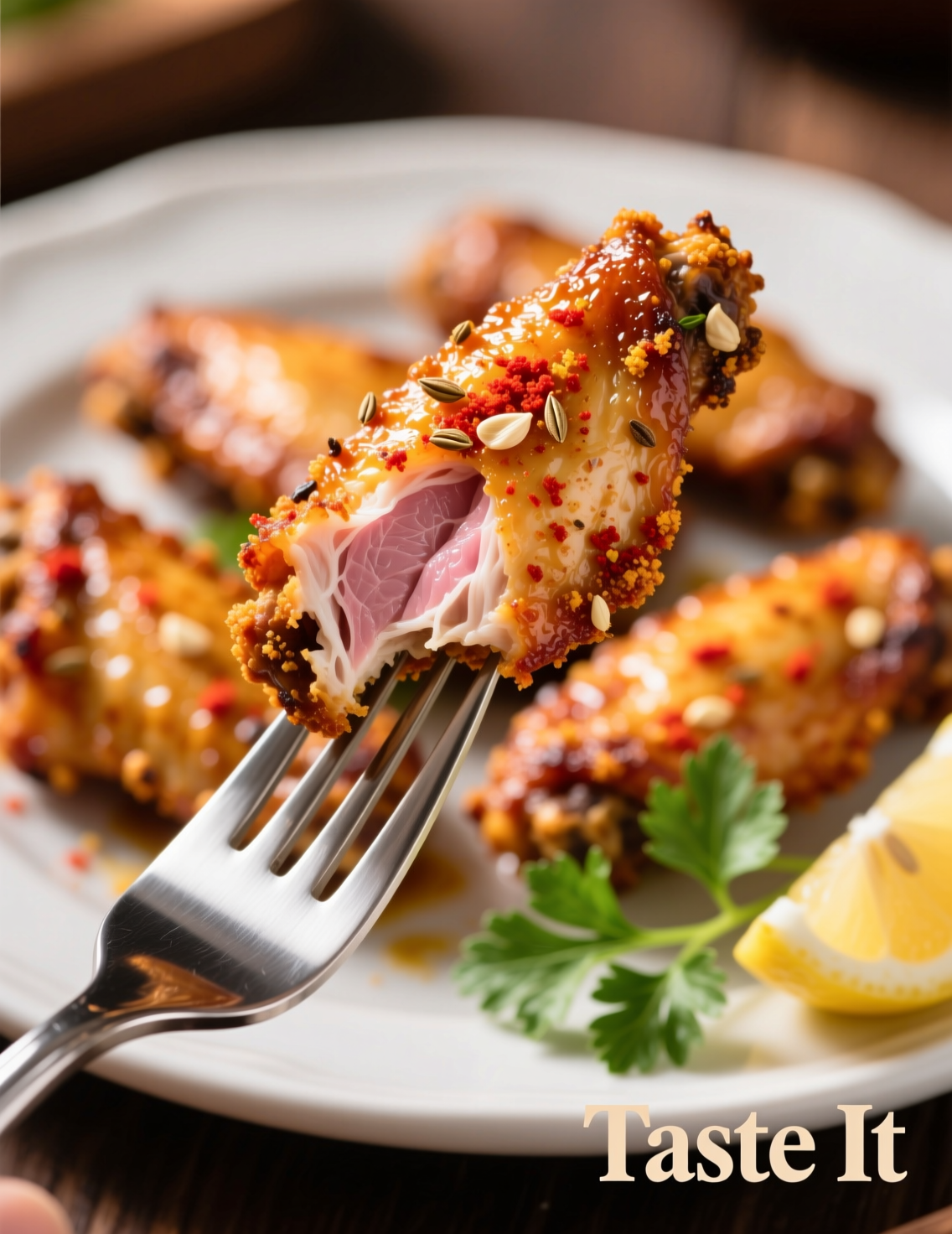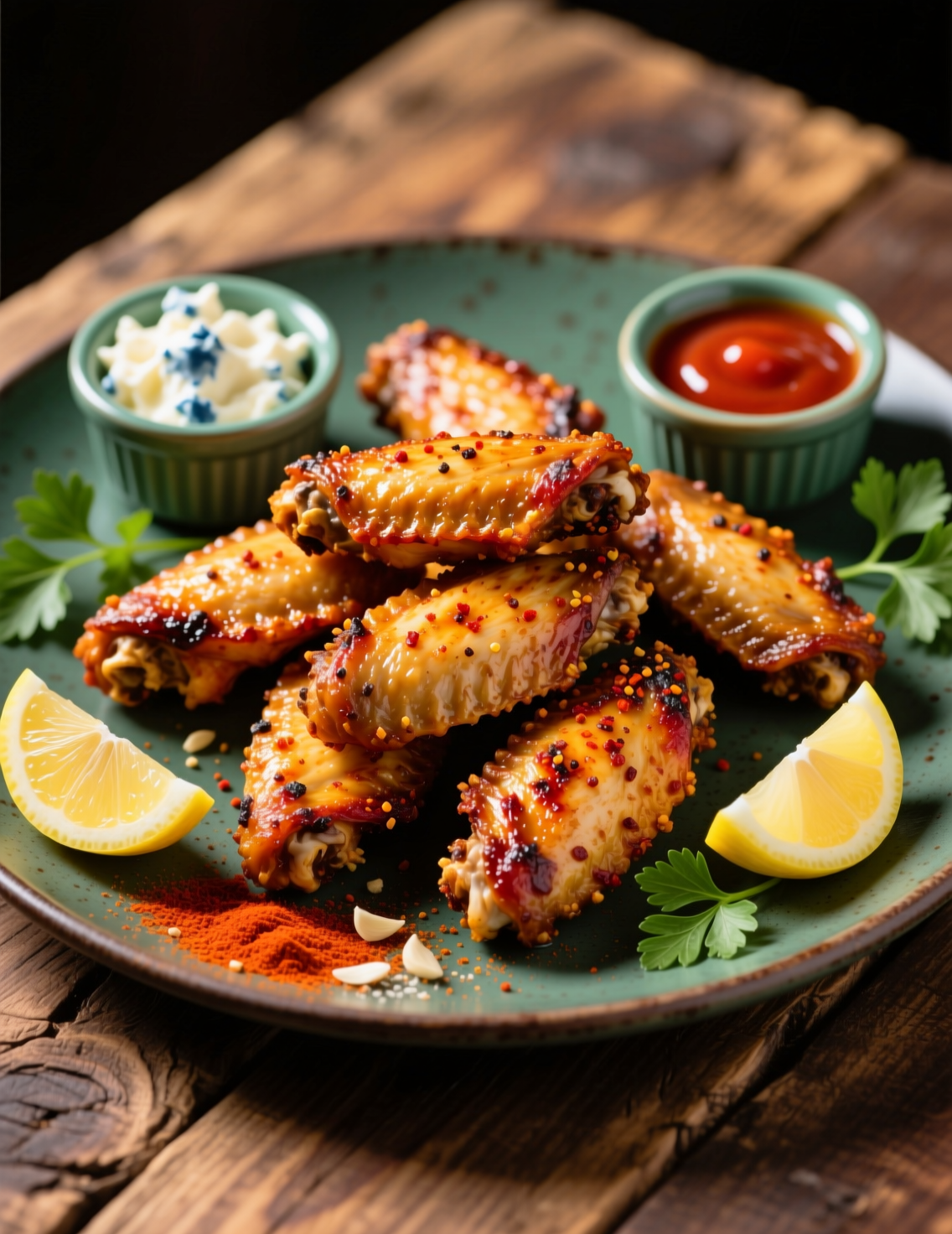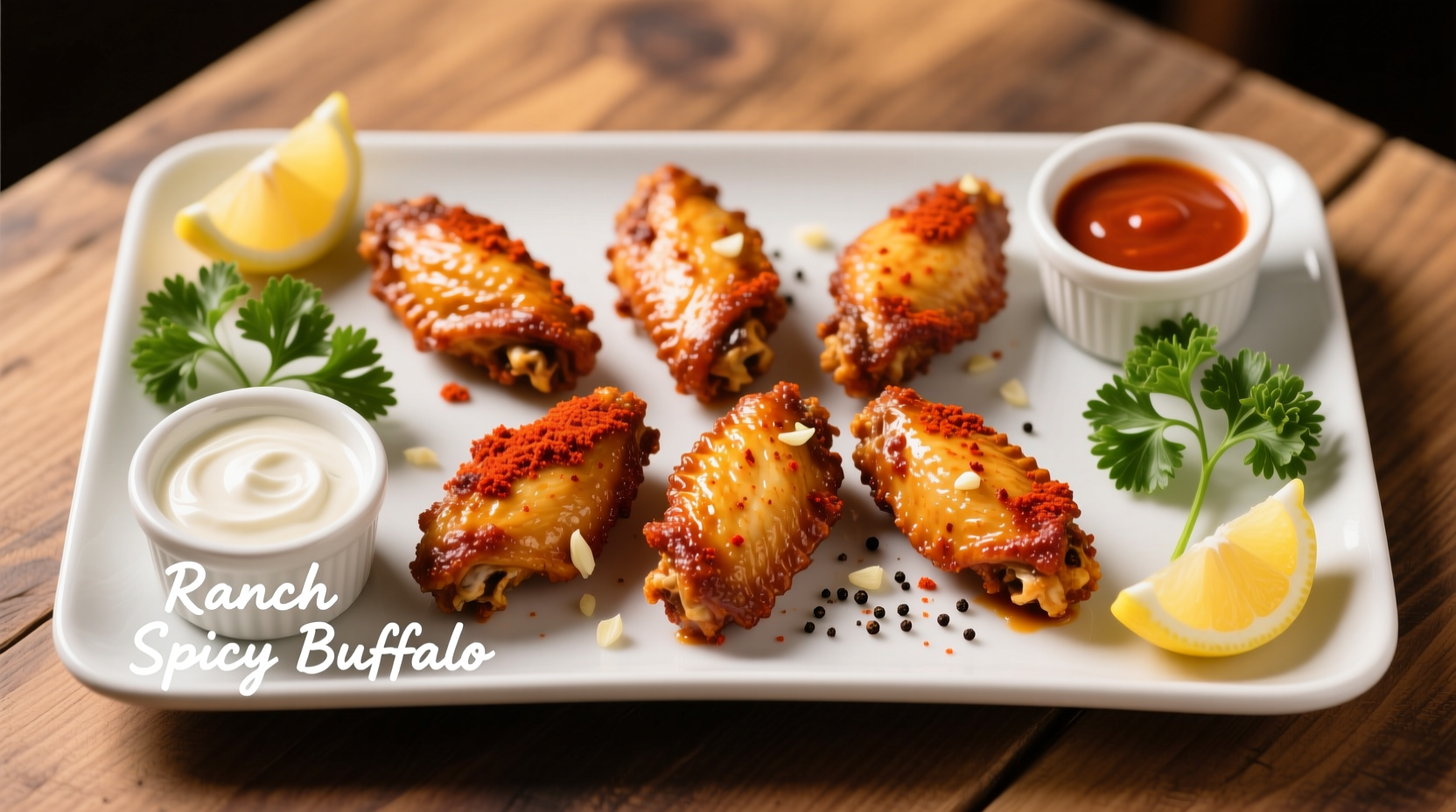Chicken wings are strange little things. Not much meat, yet so much flavor hiding under that skin. And if there’s one thing that gets everyone hooked, it’s a wing that crunches when you bite, but stays juicy inside. Crispy dry rub chicken wings do that beautifully. No messy sauce covering everything. Just spice, heat, and texture, working together in a way only dry rubs can pull off. This article dives into the craft of making them right, the science behind crispiness, and the professional tricks to elevate a humble wing into a dish that chefs respect.
Why Dry Rub Wings?
Saucy wings get all the spotlight, but dry rubs are the real chef’s playground. They give you freedom with spice layering, from smoky paprika to earthy cumin. You control every flavor, and nothing gets washed out in butter or hot sauce. Plus, rubs give wings a crust that feels almost like fried chicken, even if you bake or grill them.
A well-balanced rub not only seasons the meat but also changes its texture. Salt starts drawing out moisture, while sugar caramelizes under heat. The spices cling, turning into a crisp outer coat. In a way, the dry rub is both seasoning and technique.
Understanding the Cut
A whole chicken wing has three parts: the drumette, the flat, and the tip. For wings, we usually skip the tips—they burn fast and don’t have much to chew on. Professional kitchens prefer splitting flats and drumettes before cooking. That makes the cooking even and the eating easier.
Don’t underestimate trimming. Clean cuts help fat render evenly. And wings, more than most cuts, rely on rendered fat for crisp texture. Leave excess skin bunched, and you’ll get soggy spots.
The Science of Crispiness
Crisp wings aren’t just about heat. They’re about water. Too much moisture on the skin, and the wings steam instead of roast. Professionals know the trick: pat the wings dry, then give them time uncovered in the fridge. Even 30 minutes helps, but overnight makes the skin like parchment before it even hits the oven.
Another trick is using baking powder—not soda, but powder. It changes the pH of the skin, breaking down proteins so the skin browns faster and crunches better. It’s not new science, but still underused by home cooks.

Building the Perfect Dry Rub
There are thousands of dry rubs floating around, but for 6 servings of wings (about 3 pounds), you need balance. Here’s a professional mix that works across grilling, baking, or air frying:
- 2 tablespoons smoked paprika
- 1 tablespoon garlic powder
- 1 tablespoon onion powder
- 1 tablespoon kosher salt
- 1 tablespoon brown sugar
- 1 teaspoon cayenne pepper
- 1 teaspoon ground black pepper
- 1 teaspoon ground cumin
- ½ teaspoon mustard powder
This ratio hits smoky, sweet, spicy, and savory at once. Brown sugar is the glue—it caramelizes, giving that bronze crust. Paprika gives depth without overwhelming heat. Cayenne adds just enough kick to remind you these aren’t just snacks.
Preparation Steps
Step one: dry the wings. Pat with paper towels until they almost squeak. Place them uncovered in the fridge for a few hours if possible.
Step two: mix the dry rub. Don’t dump straight on the wings. Mix separately first so the spices distribute evenly.
Step three: toss the wings with just enough oil—about 1 tablespoon for the whole batch. This helps the rub stick but doesn’t drown them. Add the rub, toss again, and make sure every wing is coated edge to edge. Professionals sometimes wear gloves and rub by hand to avoid clumping.
Oven Method for Crisp Perfection
For 6 servings, preheat the oven to 425°F (218°C). Use a wire rack on a sheet pan. That’s key—the air needs to move under the wings. Crowding them flat on a tray makes the bottoms soggy.
Cook for 20 minutes, flip, then another 20–25 minutes. That’s about 45 minutes total. You’ll know they’re right when the edges darken and the skin feels stiff to the touch. Internal temp should read 165°F (74°C), but wings usually go higher without drying, so don’t fear 180°F.
Air Fryer Advantage
The air fryer makes crispiness almost too easy. At 400°F (204°C), 20–25 minutes is enough. Shake the basket halfway. This method gives you crisp skin without heating the kitchen, but be careful not to overcrowd. Two batches for 6 servings work better than forcing them all at once.
Grilled Wings for Smoky Depth
Grilling takes patience but rewards with smoke. Set the grill for two zones—direct heat for searing, indirect for cooking through. Start on indirect at about 375°F (190°C), then finish on direct heat to char the skin. You’ll get layers of flavor sauce-coated wings can never match.
Professional Insights on Texture
Texture is where most wings fail. Too chewy? Likely undercooked fat. Too dry? Probably too high heat too long. Too soggy? Not enough airflow or moisture left on the skin. Professionals test wings by listening: a tap with tongs should sound hollow, almost like tapping thin wood.
Some chefs brush a whisper of vinegar on the wings before rubbing. That acidity sharpens the flavor and helps balance the richness of the skin. Small tweaks like that separate restaurant-level wings from backyard versions.
Serving Ideas
Crispy dry rub wings don’t need sauce, but a dipping option never hurts. Ranch or blue cheese for creaminess. A squeeze of lime or lemon for brightness. Some chefs pair them with a cooling cucumber yogurt dip—it cuts through the spice without masking it.
For sides, think light. Celery sticks, pickled carrots, or a crisp slaw. Heavy sides can drown the wings’ effect. You want the wings to stay the star.
Common Mistakes to Avoid
One mistake is skipping the drying step. Wet skin ruins everything. Another is baking straight on foil—wings will steam instead of roast. Some cooks overdo the rub, packing on thick layers that clump and burn. Less is more; the goal is crust, not mud.
A final mistake: rushing. Wings need time. Pulling them too early gives rubbery bites. Waiting that extra 5–10 minutes can transform the texture completely.
Nutritional Perspective
For professionals, it’s good to know the breakdown. A serving of 4–5 wings with this rub runs about 280–320 calories. Protein sits at around 20 grams per serving. Fat varies depending on trimming and cooking method—air fryer wings usually come out leaner than baked or grilled. The rub itself adds minimal fat, just spice and a small sugar hit.
Industry Trends with Wings
The global chicken wing market has grown steadily, with dry rub wings gaining popularity. A 2023 survey by the National Chicken Council found 36% of consumers now prefer dry rub over traditional sauced wings. The reason? Less mess, more flavor. Restaurants are leaning into this trend by offering customizable rub blends, from coffee-chili to turmeric-ginger.
Air fryers have also pushed the home wing trend forward. Nielsen data shows air fryer sales rose 60% from 2020–2022, directly correlating with a rise in home-prepared crispy wings. This shift proves people crave professional-level crispiness without the deep fryer setup.

Variations for Professionals to Try
Adding ground coffee to the rub creates a deep bitterness that balances sweet and spicy notes. Using sumac instead of cayenne brings a tangy, Middle Eastern profile. Even cocoa powder can surprise—paired with chili, it makes a mole-inspired crust.
Some chefs use brining before the rub, especially for competition wings. A light saltwater brine with garlic and bay leaves for 2 hours changes the meat structure, giving juicier results without losing crisp skin.
Final Thoughts
Crispy dry rub chicken wings are more than a bar snack. They’re a lesson in balance—between salt and sugar, heat and air, patience and timing. The difference between good wings and great wings is often just one step more drying, or five more minutes in the oven.
For 6 servings, this recipe gives enough flavor to satisfy a crowd while still showing finesse. Professional cooks treat wings as a canvas, and this rub is the brush. Master the basics here, then start tweaking. Add spice, subtract sugar, change the cooking method. The technique stays, the creativity is yours.
FAQs
How many wings are needed for 6 servings?
About 3 pounds of chicken wings, roughly 24–30 pieces, serve six people well.
Can I use frozen wings for this recipe?
Yes, but thaw and dry them completely, or they won’t crisp properly.
Why do I need baking powder for crispy wings?
It raises skin pH, helping it brown faster and become crunchier.
Can I make these wings without sugar in the rub?
Yes, but you’ll lose some caramelization and balanced flavor.
What’s the best cooking method for maximum crispiness?
The oven with a wire rack gives the most consistent crunch.
How long should wings cook in the oven?
About 45 minutes at 425°F, flipping halfway through.
Do dry rub wings need dipping sauce?
Not required, but ranch, blue cheese, or yogurt dips complement them well.
Can I grill these wings instead of baking?
Yes, use indirect heat first, then finish with direct heat for char.
What’s the internal temperature for safe wings?
165°F minimum, though wings taste better closer to 180°F.
How do I store leftover wings?
Keep them in an airtight container in the fridge for up to 3 days.
How do I reheat wings and keep them crispy?
Reheat in the oven or air fryer at 375°F until hot and crisp.
Can I make the rub in advance?
Absolutely, store the mix in an airtight jar for up to 3 months.
Do dry rub wings work in an air fryer?
Yes, cook at 400°F for 20–25 minutes, shaking halfway through.
Are dry rub wings healthier than sauced wings?
Generally yes, because they avoid heavy butter and sugary sauces.
Can I adjust the spice level in the rub?
Of course, reduce cayenne for mild wings or add extra for heat.

Mariana is a passionate home cook who creates delicious, easy-to-follow recipes for busy people. From energizing breakfasts to satisfying dinners and indulgent desserts, her dishes are designed to fuel both your body and hustle.
When she’s not in the kitchen, she’s exploring new flavors and dreaming up her next recipe to share with the Foodie Hustle community.

